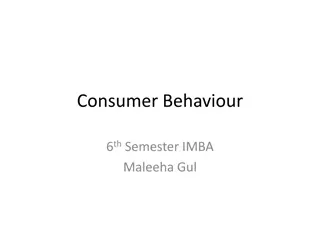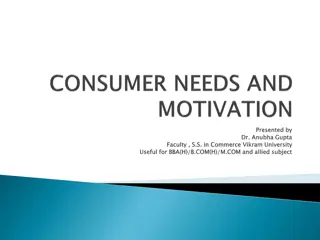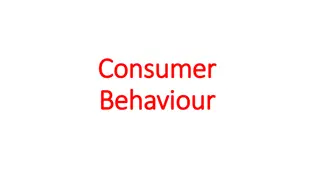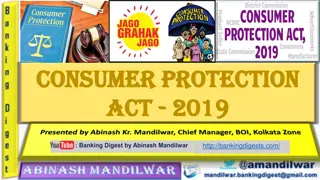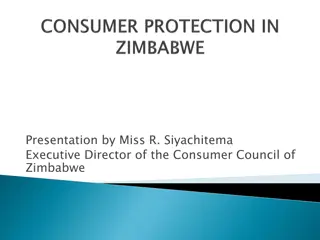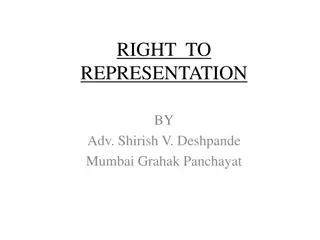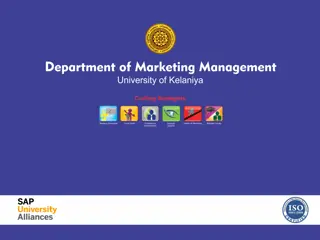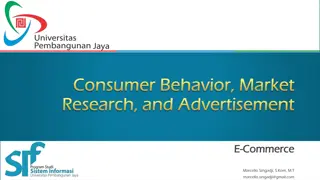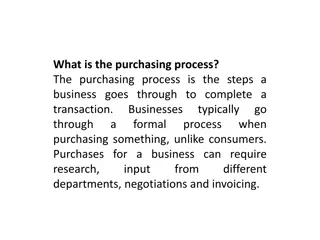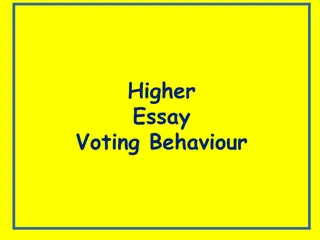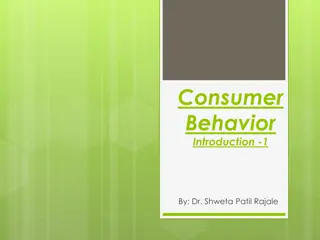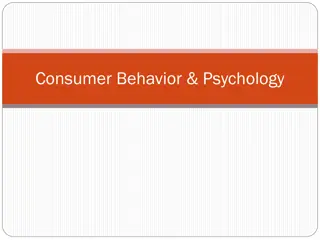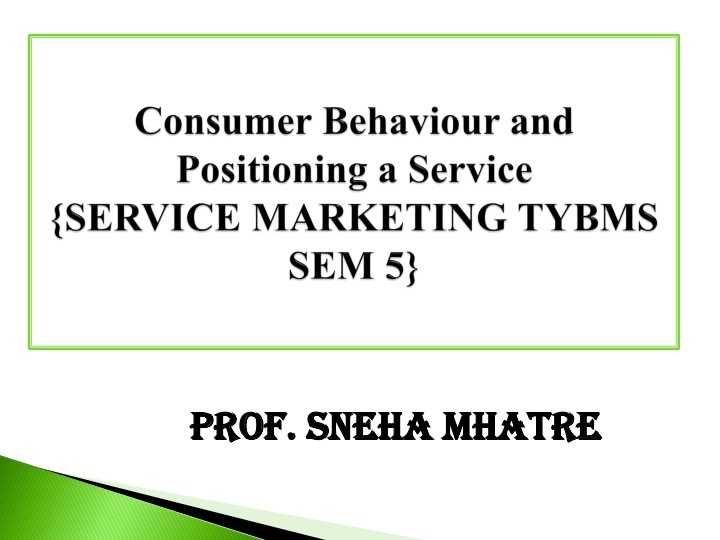
Consumer Behavior and Factors Influencing Purchasing Decisions
Consumer behavior is a complex process involving various social, personal, psychological, and cultural factors that influence individual decision-making when purchasing goods and services. Understanding these factors, such as social influences, personal traits, psychological motivations, and cultural norms, can provide insights into how consumers recognize problems, search for information, evaluate alternatives, make purchase decisions, and exhibit post-purchase behaviors. Additionally, managing customer expectations plays a crucial role in service delivery and satisfaction. This comprehensive overview sheds light on the intricacies of consumer behavior and the elements driving consumer choices.
Download Presentation

Please find below an Image/Link to download the presentation.
The content on the website is provided AS IS for your information and personal use only. It may not be sold, licensed, or shared on other websites without obtaining consent from the author. If you encounter any issues during the download, it is possible that the publisher has removed the file from their server.
You are allowed to download the files provided on this website for personal or commercial use, subject to the condition that they are used lawfully. All files are the property of their respective owners.
The content on the website is provided AS IS for your information and personal use only. It may not be sold, licensed, or shared on other websites without obtaining consent from the author.
E N D
Presentation Transcript
Prof. Prof. Sneha Sneha Mhatre Mhatre
Definition of consumer Behaviour :- According to prof. C. G. Walter and G. W. Paul, consumer behaviour is the process whereby individuals decide whether, what, when, where, how and from whom to purchase goods and service. Meaning of consumer Behaviour :- Consumer behaviour is a branch which deals with the various stages a consumer goes through before purchasing products or service for his end use. In a common men s language consumer behaviour deals with the buying behaviour of individuals.
Social factors Family influences Reference groups Role In the society Social status 1. 2. 3. 4. Personal factors Occupation Age Economic condition Lifestyle Personality 1. 2. 3. 4. 5.
Psychological factors 1. Perception 2. Motivation 3. Learning 4. Beliefs and attitudes Cultural factors 1. Culture 2. Sub-culture 3. Social class
Complex buying behavior :- for example a person wants to buy a computer such task are complex because the risk is high and the large differences in the brands and products Dissonance :- reducing buyer behavior :- consumer is highly involved in a purchase but sees a little differences in brands Habitual buying behaviour:- consumers have little involvement in purchase example salt Variety seeking buying behaviour:- chocolate
problem recognition Information search a) personal sources b) commercial sources c) public sources Evaluation of alternatives Purchase decision Post purchase behaviour
Customers expectations are the beliefs about the services delivery that serve as a standard of reference point against which performance is judged. In consumer behaviour, expectations is are seen as predictors (probabilities) made by a consumer about what is likely to happen during an impending transactions. In service marketing, however, expectations are viewed as desires public wants that is what one feels that service provider should offer rather than would offer Desired level of expectations Adequate level of expectations
Desired service expectations : a. Personal needs b. Lasting service intensifiers Zone of tolerance Adequate service expectation : a. Temporary service intensifiers b. Perceived service alternatives c. Customers self-perceived service role d. Situational factors e. Predicted service level
Ensuring promises reflect reality Performing the promised service reliably Communicating effectively with customers
A service encounters is also known as, moment of truth. Service encounter define as: any episode in which the customer comes into contact with any aspect of the organization and it s impression of the quality of it s services A service encounter is a situation where the customer interacts with the service provider. Elements of service encounter :- The customer 1. The service provider 2. The delivery system and 3. The physical evidence 4.
Remote encounters Phone encounters Face-to-face encounters Buying role :- Initiator Influencer Gatekeeper Decider Buyer User
Definition of positioning :- company s offer and image so that it occupies a distinct and valued place in the target customers mind. According to philip kotler, positioning is the act of designing the Meaning of positioning :- Positioning means projecting the image of the product or service in such a way that consumers perceives its value distinctively is that of competitive offers. It is a strategic marketing tool that allows managers to determine the organization's current position. For example:- jet airways in India has received many awards for being best airlines to serve the economy and business class travelers,
Positioning what the provider does to the mind of the service seeker in order to first create and then retain customer loyalty towards the service offering by differentiating their service offering vis- -vis competition /other alternatives. Service providers now involved in identifying improved ways of creating service appeals and are focusing on the concept of Unique Selling Proposition. It focuses on achieving a desirable position in the service seekers mind. Price, distribution, people, processes, customer service and the service itself can all affect a service provider s positioning in addition to promotion.
Positioning offers the opportunity to differentiate any service. The service provider and his service occupy a position and image in the service seeker s mind this perception influences the purchase decision made by the service seeker. The distinctive attributes must satisfy the following criteria : 1. Importance 2. Distinctiveness 3. Communicability 4. Superiority 5. Affordability 6. profitability
Determining levels of positioning Identification of attributes Location of attributes on a positioning map Implementing positioning Evaluating positions options a. b. c. Strengthening current positioning Identification an unoccupied market position Repositioning the competitors
Service attribute Quality/price positioning Competitive positioning Service application positioning Service benefits Leadership positioning Excellence positioning
Tangibles Responsiveness Empathy Assurance Reliability
Every service has customers but not every service interact with them in the same way. To consume the services customer want to be present physically in service factory when service is in progress. For e.g., 1) If any one is currently in India and want to be in America tomorrow so he simply can t avoid the boarding an international flight and spending time in a jet. you have to seat in the barber s chair yourself. When customer visit a service factory the satisfaction will be influenced by such factors as: a. Encounter with service personnel b. Appearance and features of service facilities c. Interaction with self service equipment d. Characteristics and behaviour of other customers 2) if you want your haircut you can t delegate this activity to somebody else s head but
Service recovery is the term used for systematic efforts in order to correct the problem following a service failure, and to retain a customer s goodwill. Service recovery plays a crucial role in achieving and restoring the customer satisfaction. Effective service recovery requires thoughtful procedures for resolving problems and handling disgruntled customers. It s critical to have effective recovery strategy, because even a single mistake can destroy the customers confidence in a firm under the following conditions : 1) the failure is totally outrageous 2)The problem fits a pattern of failure rather than being an isolated incident 3)The recovery efforts are weak
Apology Urgent reinstatement Empathy Symbolic atonement Follow-up
Require determination to resolve any problem Commitment, planning and clear guidelines Must be prepare to deal with angry customers Recovery efforts should be flexible Employee should be empowered to use their judgment and communication skill
Admit mistakes, but dont be defensive Act fast Don t argue with customers Show that you understand the problem from each customer s point of view Give customers the benefit of the doubt Acknowledge the customer s feeling Clarify the steps needed to solve problem Keep customer informed of the progress Consider compensation Preserving to regain customer s goodwill Taking care of customers require that the firm also take care of its own employees. Manager need to recognize that handling complaints about service failures and attempting service recovery can be stressful for the employees.
Service recovery isnt necessary a disaster for a company, if the service recovery-the action taken in response to the failure-is handled well, then customer satisfaction, trust and loyalty can actually increase. Turn customers frustration into customer loyalty. There are several areas where companies can improve their service recovery : 1. Recovery is proactive, complaint handling reactive 2. Provide the right type of justice 3. Understand the scale of the problem 4. Encourage customers complaints 5. Know where you are failing
Complaint handling should be seen as a profit centre, not a cost centre. When a dissatisfied customer defects the firm loses more than just the value of the next transaction. Therefore it pays to invest in service recovery efforts designed to protect those long term profits effective service recovery requires thoughtful procedures for resolving problems and handling dissatisfied customers. When the complaints are made after the fact, the option for recovery is more limited.
There are different levels of the customer contact with the service. As the level of customer contact with the service operation increases, service encounters are likely to be longer and more frequent. There are three levels of customer contact representing the extent of the interaction : 1) High-level contact 2) Medium level contact 3) Low level contact
Customer resistance to change I familiar environment and long-established behavioral pattern can effective various attempts to improve productivity and even quality. Managers of service operations can and should avoid such insensitivity towards their customers. There are six possible steps to do it : Develop customer trust Understand customers habits and expectations Pre-test new procedures and equipments Publicize the benefits Tech customers to use innovations and promote trial






